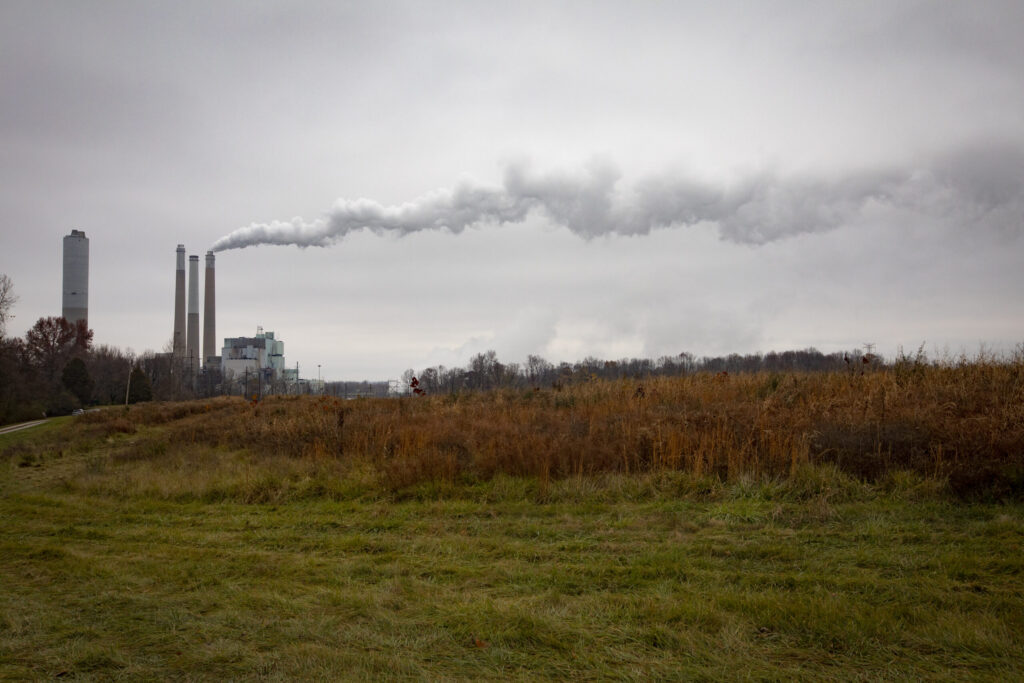Pictured here is AES Indiana’s Petersburg Generating Station, a coal-fired power plant in Petersburg, Indiana. (Robert Zullo | States Newsroom)
The Harrison Power Station, a coal-fired power plant in Harrison County, was the ninth highest emitter of greenhouse gases in the nation in 2023, according to data released last week by the federal Environmental Protection Agency.
The EPA’s 2023 Greenhouse Gas Reporting Program looked at emissions from 6,470 power plants, chemical plants, factories, natural gas producers, refineries and more across the country.
According to the data, Harrison Power Station — which is operated by Mon Power, a subsidiary of FirstEnergy Corp. — released about 11.18 million metric tons of greenhouse gases into the environment last year. That’s about a 4.4% decrease in emissions at the plant compared to 2022, when the power station was ranked eighth nationally for greenhouse gases released.
There were a total of 113 West Virginia facilities included in the EPA’s greenhouse gas report. Thirteen of those facilities were in the top 10% of greenhouse gas emitters nationwide. Along with the Harrison Power Station, the John E. Amos Power Plant was in the top 1% of emitters. The South Charleston power plant ranked 20th nationally and released 87.5 million metric tons of greenhouse gases into the atmosphere last year.
Combined, all West Virginia facilities reporting to the EPA released 64.6 million metric tons of greenhouse gases into the air in 2023, a 4.9% decrease in emissions compared to 2022 and an 18.7% decrease in emissions compared to 2013.
A vast majority of Harrison Power Station’s 2023 emissions — more than 99% of them, per the data — were carbon dioxide. Other kinds of emissions released by the Harrison Power Station were methane (about 33,000 metric tons) and nitrous oxide (nearly 57,000 metric tons).
Carbon dioxide, methane and nitrous oxide — as well as other greenhouse gases — are known to be the leading cause of climate change worldwide as they trap heat in the atmosphere which warms the planet. They are also known to increase air pollution and smog, contributing to asthma and other respiratory conditions for people who live in places with high concentrations of them in the air.
Almost all the greenhouse gases emitted by Harrison Power Station are used for electricity generation. The power plant supplies energy to the PJM electrical grid, which serves 13 states and the District of Columbia.
Over the last 10 years, greenhouse gas emissions at the Harrison Power Station peaked in 2017, when the plant produced 12.3 million metric tons of greenhouse gases. That year, it was ranked 15th in the nation for its emissions.
To date, there has been little oversight in the U.S. regarding carbon emissions from coal-fired power plants, which are the largest source of greenhouse gas emissions in the country, according to the EPA. In April, the EPA released new, finalized rules that will require all coal-fired power plants in the nation that plan on operating past 2039 to cut or capture 90% of their carbon emissions by 2032.
The rules have been criticized by numerous West Virginia officials and several states — including West Virginia — filed a legal challenge against the new rules. Attorney General Patrick Morrisey, who is running a Republican campaign to be the state’s next governor, has called them a tactic by President Joe Biden’s administration to shut down coal-fired power plants across the nation.
Environmental advocates have touted the more stringent policies, hoping over time they will help clean up historically polluted areas where health issues persist due to toxins and residents are forced to live without guaranteed access to clean water or air.
Last week, the United States Supreme Court declined to issue an emergency stay that would have halted the implementation of the new rules, which also deal with coal ash, wastewater and mercury pollution.
The Harrison Power Station is scheduled to remain in operation until 2040, meaning it will need to meet the EPA’s new environmental standards.
In a statement this week, FirstEnergy spokesperson Will Boye said that the company is following “the developments around the EPA rule and any potential impacts on FirstEnergy.”
“FirstEnergy operates its plants in compliance with all applicable environmental rules and regulations,” the statement continued.
Boye did not respond to questions regarding Harrison Power Station’s carbon emissions or any work that is planned to cut those emissions by the EPA’s deadline.

